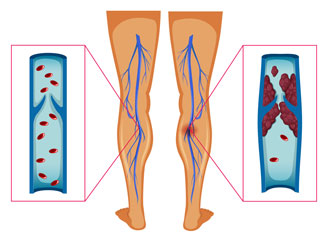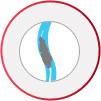Deep Vein Thrombosis (DVT)

The condition in which blood clot forms in the deep veins of the body is referred to as Deep Vein Thrombosis (DVT). The main reasons which promote clot formation are stagnation of blood flow, damage to the vein vessel wall and in instances where the blood is thicker than normal with an increased tendency for clot formation. DVT occurs most often in the deep veins of the legs and thighs.
What are the risk factors for DVT?
- Prolonged periods of inactivity such as hospital stay or recovery from surgery, sitting for a long time during travels such as by car or plane
- Certain medical conditions including cancers, pregnancy, obesity and heart failure
- Medications such as oral contraceptive pills and hormone replacement therapy
- Previous history of DVT or family history of DVT
- Certain blood disorders which make the blood thick and likely to clot easier
What are the symptoms of DVT and how is it diagnosed?
Symptoms
The symptoms occur in the affected leg and include:
- Pain or tenderness in the leg
- Swelling of the leg
- Increased warmth over the affected area
- Changes in the skin colour
Diagnosis
- Physical examination of your legs for swelling, tenderness or skin discolouration.
- Blood test - D-dimer
- Duplex ultrasound scan of the legs
- CT or MRI scan may provide clearer images of the deep veins when contemplating invasive treatment.
What are the treatment options?
The treatment options include conservative and invasive measures.
Conservative:

Medications
- Medications Your doctor will prescribe anti-coagulants (or blood thinners) that reduce the blood’s ability to clot. The role of these medications is to prevent the clot from extending and also reduces the risk of life threatening complication of pulmonary embolism where the clot travels to the lungs. The medication is initially administered as an injection which takes immediate effect and subsequently in the tablet form.

Compression Stockings
- Compression stockings are designed to help reduce the swelling in the legs following DVT and it also improves the drainage of blood from the legs.
Invasive:

Thrombolysis
-
Thrombolysis is a treatment option that is available in cases where DVT affects the larger veins in the groin and lower abdomen (also known as ilio-femoral DVT). This treatment involves administering a thrombolytic agent which is a medication that breaks down clot. The medication is administered via a catheter which is a small plastic tube placed directly into the clot. However, it is also a procedure that has significant risks associated with its use particularly the risk of bleeding. Hence this treatment may not be suitable for all patients especially when the risk of bleeding due to other associated conditions makes them high risk.
The risk of chronic venous insufficiency (discussed under Chronic Venous Ulcers) and other complications in later life are higher in patient with ilio-femoral DVT and thrombolysis treatment may help reduce the severity of these symptoms in later life.
What are the complications of DVT?
- Untreated DVT can cause further extension of the clots along the deep veins and lead to pulmonary embolism (PE). PE is a serious condition in which the blood clot breaks up (known as embolus) from the deep veins and travels along with the blood flow and lodges in the lung, blocking the blood flow into the lung.
- Post- phlebitis syndrome (PPS) is a chronic complication of DVT and is characterised by swelling, skin discolouration, pain in the affected leg and recurrent sores (ulcers).
How can DVT be prevented?
If you are at risk of developing DVT, you can help prevent it by:
- Remaining active and avoiding prolonged periods of inactivity. During long haul flights and car travel ensure that you stretch your legs and take regular breaks from sitting to exercise your calf muscles
- Wearing compression stockings
- Your doctor might prescribe blood thinning medications if you are at high risk of DVT
- Lifestyle modification such as weight reduction and regular exercises
- In a hospital setting some of the steps taken to reduce the risk of DVT are compression stockings, regular injections or tablets to keep the blood thin, mechanical calf pumps to squeeze the blood from the legs and also early mobilisation after surgery.
